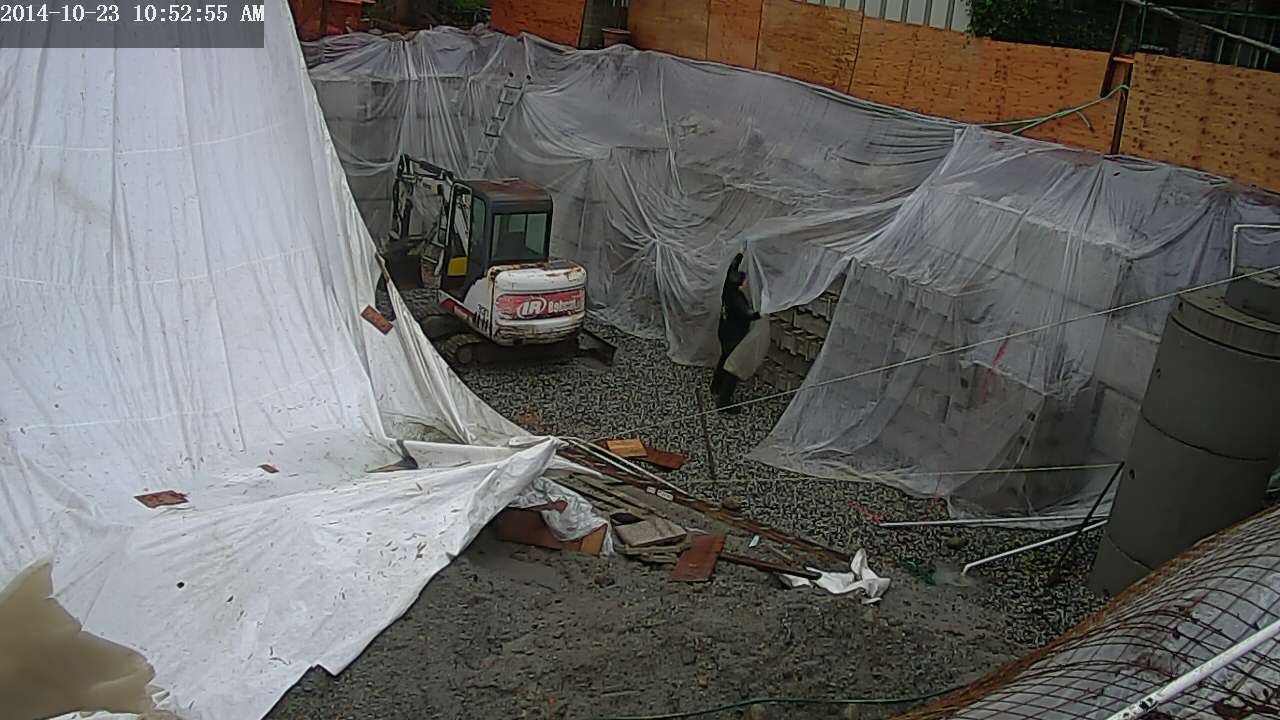I have a plan!
Yesterday I took back the winch I bought from Princess Auto and instead bought this Champion 4500 Lb winch from Canadian Tire. It was regularly $399 on sale for $229.99 (cheaper than the one I took back).
Yesterday afternoon, I tried it out and it did much better raising the main cable but still could not get the cable all the way up. But I got enough slack to now attach to the truck and lo and behold the truck could no longer pull it up all the way either. Some investigation work with binoculars showed that the cable was wound around a branch and having to slice through the branch to go anywhere. I also noticed that all of this raising and lowering of the cables was causing it to cut through the metal shackles. So now I was worried at the presumed weakened state of the top shackle and not wanting to pull too hard in case it snapped.
I raised the tarp about 75% of the way (after pupping off what appeared to be 300-400 gallons of pooled water from on top of the tarp from the previous nights storm), and then started working on the front attachment points. That is when I realized that the tarp has stretched a lot more over the last few weeks and that no matter how tightly I attached the front side, I would still be left with valleys the water would puddle. I finished the day seriously contemplating finally giving up! And if I did give up on the tarp, would I just put the project on hold till the spring?
Then today happened. Brian from Embers came and re-stacked all of the ICF block in the pit along the north wall where it will be out of the way of digging the final footings and spreading the granular layer along the pit floor. Half the pit was covered with tarp and the other half was not, so it was a very definitive example of the difference in working conditions. Unfortunately, while Brian was moving block, I was basically topside working without the benefit of the tarp and was soaked through in a matter of minutes.

Now most construction people would just say “suck it up buttercup” and I would totally agree. While miserable, it is not impossible and you just have to push through. I have worked on construction jobs in the rain many times and you just deal with it. But it was my afternoon road trip that cemented my commitment to not build a house exposed.
There were three houses under construction (started within last month) that are near me. All three have just started framing first storey floor assembly or just starting first floor walls. None were tarped. In all cases the plywood floors were de-laminating and I could see bows in the floor caused by sagging of the floor trusses in their saturated state.
Now, if you are putting on a concrete skim coat for hydronic heating, you can get away with some bowing of the floor, but we are not. So we would have a permanent deflection visible in our finished floors unless a lot of effort was made to scarf out the dips with thin ply (door skins) or levelling compound. Not to mention the twisting and bowing of the studs you would then need to contend with. Then of course, your wood has come to fibre saturation (32% wood moisture) and now has been initiated for fungi growth.
This is the standard way to build in my region, but I refuse to work as hard as I know I will be, just to build a poorly constructed and performing dwelling. SO tarp failure is NOT AN OPTION and thankfully I have a plan. And the plan is a total departure from what I have been trying to do to date.
Up till now, other than the top main cable, I have been using the tarp itself as the structure needing to hold it up. I have attached the tie down chords to the edge of the tarp and used the tarp material itself to transfer these loads up to the top cable. Because we needed to keep the tarp from sagging, these ties down cables have been snugged extremely tightly (I was using the truck to tension them). But this is a plastic tarp, so it was just stretching or the tension was just ripping the tarp at any significant wind load.
I will now take the tarp out of the equation and make the structure out of rope. The tie downs chords will continue all the way up to the main overhead cable allowing the tarp to just ‘sit on top’ of the chords. I will create a grid work of ropes that the tarp will lie on to prevent any significant pooling. I will still attach the tarp at the outside edges so that it does not blow away, but will ensure the tarp is slacker than the rope so that it is not under tension. The tarp can still balloon up with certain winds, but this has never placed a lot of strain on the tarp. It is the top down winds that were trying to tear it to bits and this will be prevented with the supporting rope grid. Yes this will take a few days and cause further delay, but the difference in efficiency working under cover will more than make up for it.
Wish me well and thanks for visiting.

The rain here has been crazy this week. Brace for Hurrican Ana on Tuesday FYI.
I see Hammer & Hand use jobsite tents which would be a real luxury:
http://www.stuartrental.com/construction-gallery
hylomar –
Great Jobsite Tarp Gallery. I have seen similar systems here that use a
aluminum box channel support system. Rentals start at about $15K. I
am trying to achieve the same for about $3K.